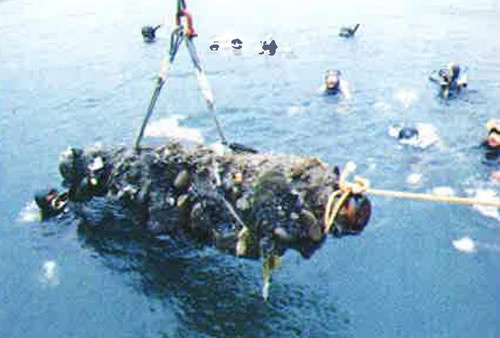Esashi Town, Hokkaido Prefecture
End of the Edo–Meiji periods (latter half, nineteenth century)

Kaiyō Maru
The Kaiyō Maru sank at a point 350 m out to sea from the town of Esashi in southwestern Hokkaido, facing the Sea of Japan.

Task of raising a cannon
As divers kept a lookout in the water, a 30-pound shell gun of Belgian make was raised. Covered in seaweed and shellfish, the barrel was 2 m 42 cm in overall length, and weighed 1,686 kg.

Conditions of the investigation
Using the same methods as for excavations on dry land, a map was drawn of artifacts on the seabed.

Ship’s hull in situ
This appears to be a portion of the material of the deck. The ship continues to be preserved at the seabed in its current condition, and to guard against shipworms and so forth it is protected with copper plating and copper mesh.
A tragic warship that sank in the northern seas
The Kaiyō Maru was a wooden warship commissioned by the Tokugawa Shogunate in 1863 and built by the Dutch firm C. Gips and Sons. Equipped with 26 high-powered German-made guns, she saw service as the shogunate’s flagship during a time of great upheaval at the end of the Edo period. However, in the first year of the Meiji era (1868), shortly after rule was surrendered back to the emperor, as she was sailing to support the attack upon Esashi in Hokkaido by former armed forces of the shogunate under Enomoto Takeaki, the ran aground due to violent wind and rain and sank just of the coast of Esashi.
Since the shipwreck, there have been repeated attempts to salvage artifacts from the Kaiyō Maru, with records left of large amounts of ship fittings and weaponry being recovered in 1873 and 1874. Subsequently, while the precise location was lost for a period of time, in 1975 the first full-fledged underwater excavation in Japan got underway. The impetus came from the impending crisis of the ship’s destruction due to the construction of a breakwater, and also an emerging concern that as the sea currents changed the remains would become exposed or dispersed. The excavation was conducted taking reference from examples in foreign countries and repeatedly considering the methods for recovering artifacts and for their preservation, and over a 10-year period about 30,000 items were salvaged.
Beginning with parts of the ship, its fittings, and engine, the artifacts include cannons and guns used in actual battle, plus Japanese swords and other weapons, as well as utensils of daily life of the crew. In particular, among the weaponry, there are precious materials illustrating the transition from older to modern forms of artillery. (Okuyama Satomi)

